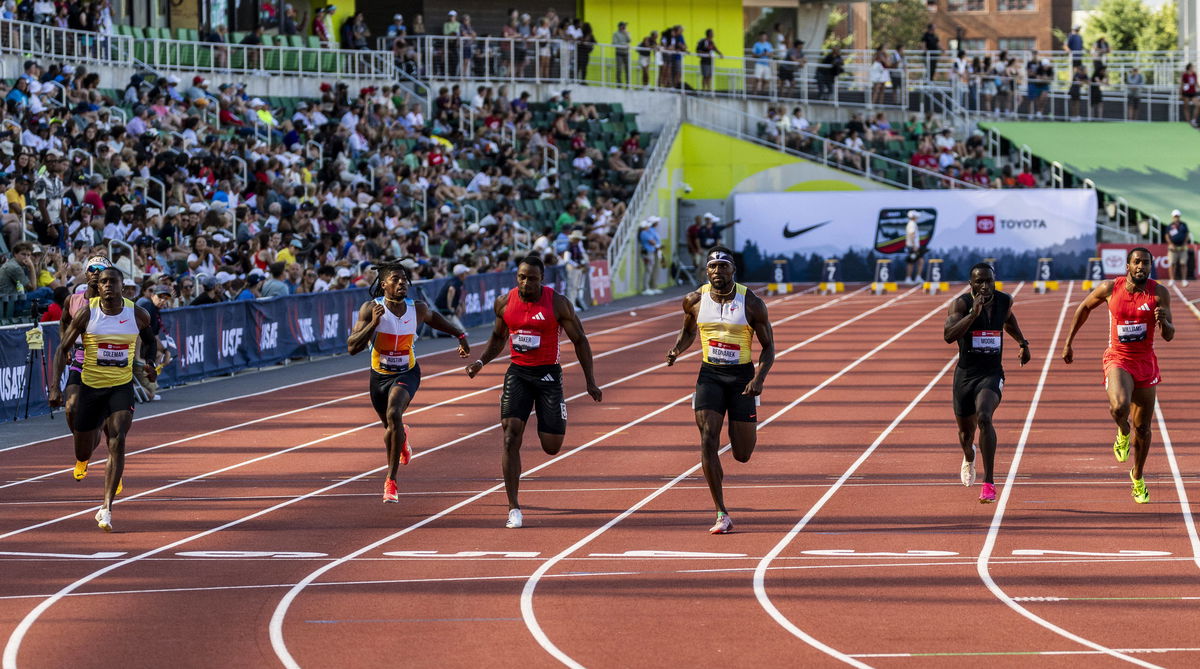
Imago
August 01 2025 Eugene, OR U.S.A. CAPTION CORRECTION: Mens 100 meter athletes Christian Miller,Christian Coleman, Pjai Austin, Ronnie Baker, Kenny Bednarek, Marcellus Moore and Kendal Williams running the 100 meter in heat three during the USATF Outdoor Track and Field Championship Day 2 at Hayward Field Eugene OR / CSM Eugene USA – ZUMAc04_ 20250801_zma_c04_225 Copyright: xThurmanxJamesx

Imago
August 01 2025 Eugene, OR U.S.A. CAPTION CORRECTION: Mens 100 meter athletes Christian Miller,Christian Coleman, Pjai Austin, Ronnie Baker, Kenny Bednarek, Marcellus Moore and Kendal Williams running the 100 meter in heat three during the USATF Outdoor Track and Field Championship Day 2 at Hayward Field Eugene OR / CSM Eugene USA – ZUMAc04_ 20250801_zma_c04_225 Copyright: xThurmanxJamesx
The World Athletics Championships return to Tokyo this weekend, four years after the city hosted the pandemic-delayed Olympics of 2021. The event began on Saturday, September 13, and would run through Sunday, September 21, drawing more than 2,000 athletes from 200 nations. It is the 20th edition of the championships, a competition that has taken place every two years since 1991. Japan, which outbid Nairobi, Singapore, and Chorzów for the right to host, now becomes the first country to stage the championships on three occasions, following Tokyo in 1991 and Osaka in 2007.
Watch What’s Trending Now!
Yet, despite the scale of the competition, it is not medals alone that dominate conversation. The weather forecast, track conditions, and their direct effect on athlete performance are emerging as defining themes of the Tokyo 2025 meet. Unfortunately, while the hype surrounding the event is sky-high, things are looking a bit rough, courtesy – the weather.
ADVERTISEMENT
What is the weather forecast for Tokyo during the World Championships 2025?
Current forecasts indicate that the opening weekend will be uncomfortably hot and humid. Temperatures in Tokyo are projected to hover around 32–33°C, though the “feels like” or RealFeel measure will be closer to 38–39°C due to humidity levels of 80–85 percent. On Saturday, the expected high is 30°C with 75 percent humidity, climbing to 34°C on Sunday.
Thunderstorms are likely in the late afternoon and evening, with light to moderate winds from the east-southeast. At present, the temperature in Tokyo is 28°C. These conditions place endurance athletes in particular at heightened risk, while sprint and field specialists may see performance gains in warm air.
Top Stories
Cam Newton Makes NFL Return Conditions Clear to 32 Teams as Panthers Legend Confirms Retirement Stance

Caitlin Clark Shows Concerning Signs vs. Kelsey Plum During USA Camp Debut, per National Reporter

Tom Brady Makes Career Announcement for Vegas as Pete Carroll Addresses Losing Raiders Locker Room

“RIP”: Prayers Pour In as Tom Brady’s Raiders Struck by Tragedy

“NFL Was Crying”: Maxx Crosby Says League Forced Him to Remove Shoes Honoring His Daughter

“Rest in Peace”: Prayers Pour In From Dan Marino as Dolphins Legend Mourns Tragedy in South Florida Football

Record-high temperatures and debilitating humidity have prompted World Athletics Championships organizers to move up the start times for the race walk and marathon events this weekend. 👉 https://t.co/3UHAjJ0We0 pic.twitter.com/TCemg5nIpG
— The Japan Times (@japantimes) September 11, 2025
ADVERTISEMENT
The JMA noted that 15 cities across Japan have recorded their highest-ever temperatures in recent weeks, underscoring the severity of the summer. The agency’s data points to a climate trend that will not only affect these championships but also raise questions about the scheduling of future major competitions. For participants, the immediate concern is how to adapt. Organizers are preparing cooling strategies and on-field wet-bulb-globe-temperature assessments to safeguard competitors during the most demanding events.
ADVERTISEMENT
How do track surface and stadium conditions influence athlete performance?
While weather is the most visible factor, surface quality and stadium conditions also play critical roles. Research has shown that surface stiffness can directly influence repeated-sprint capability. Comparisons between natural turf and artificial turf in simulated matches found that athletes’ repeated-sprint performance declined on softer natural turf, indicating that speed and recovery are more difficult on less rigid surfaces. For Tokyo, the Japan National Stadium’s track is designed to optimize rebound, but in hot conditions, the added heat radiating from the surface may increase strain on the body.
Athletes in endurance events, such as the marathon and race walks, face compounded stress under such circumstances. Heat and humidity accelerate rises in core body temperature, increasing the risk of exertional heat illness. Heat acclimatization programs, adjusted warm-up durations, and cooling interventions, such as ice vests and shade tents, are now standard practices for teams preparing in Tokyo. For sprinters and throwers, however, warmer temperatures can sometimes aid explosive performance, as muscles tend to function more effectively in heat, provided hydration and recovery are maintained.
ADVERTISEMENT
How have past Championships been impacted by similar conditions?
The warning signs are not hypothetical. During the 2019 World Championships in Doha, the women’s marathon was staged in 32°C heat with 74 percent humidity, producing a 41 percent did-not-finish rate. In the same championships, thermoregulatory studies on race walk athletes recorded core body temperatures well above safe thresholds, with ambient conditions between 29.3–32.7°C and humidity levels ranging from 46 to 81 percent. The findings underscored how quickly the human body reaches dangerous limits in endurance competition under such stress.
Tokyo itself has a recent precedent. At the 2021 Olympics, marathon and race walk events were relocated to Sapporo, nearly 800 kilometers to the north, to escape oppressive conditions. That decision, taken in response to forecasts of extreme heat in the capital, remains a reference point as Tokyo hosts again in 2025. This time, however, the events will stay in the city, finishing inside the Japan National Stadium, placing an even greater emphasis on medical support and race scheduling.
Even less than a month back, on August 20, 2025, the Athletissima Diamond League meet in Lausanne, marking its 50th anniversary, was heavily disrupted by torrential rain that forced the cancellation of the women’s pole vault and altered conditions across multiple events. The men’s long jump was interrupted as organizers tried to clear water from the landing area, with only Tajay Gayle attempting the final rounds, his effort deemed illegal, leaving Anvar Anvarov declared the winner from an earlier jump. The wet and cool weather also hampered overall performance, with several athletes struggling to adapt, including women’s high jump world record holder Yaroslava Mahuchikh, who withdrew early from the competition.
ADVERTISEMENT
The contrast between disciplines is striking. Sprinters often welcome warmer air that keeps muscles loose and reduces injury risk, while distance runners and walkers must contend with higher cardiovascular strain and dehydration. The balance of these effects will be central to the unfolding narrative of the championships. Athletes and coaches have tailored preparation around these factors, knowing that medals may be decided as much by adaptation strategies as by training or talent.
The 2025 World Athletics Championships promise moments of sporting brilliance, but they will also test the limits of resilience under climate stress. Tokyo has hosted before, but never in conditions quite like these. What happens over the next nine days may influence how the sport confronts rising temperatures in future global events.
ADVERTISEMENT
ADVERTISEMENT
ADVERTISEMENT

